Catalytic Decomposition of an Energetic Ionic Liquid Solution over Hexaaluminate Catalysts
Abstract
:1. Introduction
2. Results and Discussion
2.1. Characterization of Hexaaluminates
2.2. Catalytic Decomposition of the Liquid Monopropellants
2.3. Repeatability Experiments in Catalytic Decomposition of the ADN-Based Liquid Monopropellants
3. Materials and Methods
3.1. Synthesis of Hexaaluminates
3.2. Characterization of Catalysts
3.3. Thermal and Catalytic Decomposition of Liquid Monopropellants
4. Conclusions
Author Contributions
Funding
Conflicts of Interest
References
- Courtheoux, L.; Gautron, E.; Rossignol, S.; Kappenstein, C. Transformation of platinum supported on silicon-doped alumina during the catalytic decomposition of energetic ionic liquid. J. Catal. 2005, 232, 10–18. [Google Scholar] [CrossRef]
- Amrousse, R.; Hori, K.; Fetimi, W.; Farhat, K. HAN and ADN as liquid ionic monopropellants: Thermal and catalytic decomposition processes. Appl. Catal. B Environ. 2012, 127, 121–128. [Google Scholar] [CrossRef]
- Farshchi, M.; Vaezi, V.; Shaw, B.D. Studies of HAN-based monopropellant droplet combustion. Combust. Sci. Technol. 2002, 174, 71–97. [Google Scholar] [CrossRef]
- Amrousse, R.; Katsumi, T.; Azuma, N.; Hori, K. Hydroxylammonium nitrate (HAN)-based green propellant as alternative energy resource for potential hydrazine substitution: From lab scale to pilot plant scale-up. Combust. Flame 2017, 176, 334–348. [Google Scholar] [CrossRef]
- Zhang, T.; Li, G.; Yu, Y.; Sun, Z.; Wang, M.; Chen, J. Numerical simulation of ammonium dinitramide (ADN)-based non-toxic aerospace propellant decomposition and combustion in a monopropellant thruster. Energy Convers. Manag. 2014, 87, 965–974. [Google Scholar] [CrossRef]
- Agnihotri, R.; Oommen, C. Cerium oxide based active catalyst for hydroxylammonium nitrate (HAN) fueled monopropellant thrusters. RSC Adv. 2018, 8, 22293–22302. [Google Scholar] [CrossRef]
- Lee, H.; Litzing, T.A. Chemical kinetic study of HAN decomposition. Combust. Flame 2003, 135, 151–169. [Google Scholar] [CrossRef]
- Kleimark, J.; Delanoë, R.; Demairé, A.; Brinck, T. Ionization of ammonium dinitramide: Decomposition pathways and ionization products. Theor. Chem. Acc. 2013, 132, 1–9. [Google Scholar] [CrossRef]
- Courthéoux, L.; Amariei, D.; Rossignol, S.; Kappenstein, C. Thermal and catalytic decomposition of HNF and HAN liquid ionic as propellants. Appl. Catal. B Environ. 2006, 62, 217–225. [Google Scholar] [CrossRef]
- Vyazovkin, S.; Wight, C.A. Ammonium dinitramide: Kinetics and mechanism of thermal decomposition. J. Phys. Chem. A 1997, 101, 5653–5658. [Google Scholar] [CrossRef]
- Gronland, T.A.; Westerberg, B.; Bergman, G.; Anflo, K.; Brandt, J.; Lyckfeldt, O.; Agrell, J.; Ersson, A.; Jaras, S.; Boutonnet, M.; et al. Reactor for Decomposition of Ammonium Dinitramide-Based Liquid Monopropellants and Process for the Decomposition. U.S. Patent 7137244B2, 21 November 2006. [Google Scholar]
- Osman, A.I.; Abu-Dahrieh, J.K.; McLaren, M.; Laffir, F.; Rooney, D.W. Characterisation of Robust Combustion Catalyst from Aluminium Foil Waste. Chem. Sel. 2018, 3, 1545–1550. [Google Scholar] [CrossRef]
- Giannikos, A.; Frantzis, A.D.; Pliangos, C.; Bebelis, S.; Vayenas, C.G. Electrochemical promotion of CH4 oxidation on Pd. Ionics 1998, 4, 53–60. [Google Scholar] [CrossRef]
- Nishino, A. Household appliances using catalysis. Catal. Today 1991, 10, 107–118. [Google Scholar] [CrossRef]
- Machida, M.; Eguchi, K.; Arai, H. Catalytic properties of BaMAl11O19−α (M = Cr, Mn, Fe, Co, and Ni) for high-temperature catalytic combustion. J. Catal. 1989, 120, 377–386. [Google Scholar] [CrossRef]
- Machida, M.; Eguchi, K.; Arai, H. Effect of structural modification on the catalytic property of Mn-substituted hexaaluminates. J. Catal. 1990, 123, 477–485. [Google Scholar] [CrossRef]
- Yeh, T.F.; Lee, H.G.; Chu, K.S.; Wang, C.B. Characterization and catalytic combustion of methane over hexaaluminates. Mater. Sci. Eng. A 2004, 384, 324–330. [Google Scholar] [CrossRef]
- Hong, S.; Heo, S.; Li, C.; Jeon, B.K.; Kim, J.M.; Jo, Y.M.; Kim, W.; Jeon, J.K. Preparation of Mesoporous CuCe-Based Ternary Metal Oxide by Nano-Replication and Its Application to Decomposition of Liquid Monopropellant. J. Nanosci. Nanotechnol. 2018, 18, 1427–1430. [Google Scholar] [CrossRef]
- Thommes, M.; Kaneko, K.; Neimark, A.V.; Olivier, J.P.; Rodriguez-Reinoso, F.; Rouquerol, J.; Sing, K.S.W. Physisorption of gases, with special reference to the evaluation of surface area and pore size distribution (IUPAC Technical Report). Pure Appl. Chem. 2015, 87, 1051–1069. [Google Scholar] [CrossRef] [Green Version]
- Tian, M.; Wang, X.D.; Zhang, T. Hexaaluminates: A review of the structure, synthesis and catalytic performance. Catal. Sci. Technol. 2016, 6, 1984–2004. [Google Scholar] [CrossRef]
- Tabesh, S.; Davar, F.; Loghman-Estarki, M.R. Preparation of γ-Al2O3 nanoparticles using modified sol-gel method and its use for the adsorption of lead and cadmium ions. J. Alloys Compd. 2018, 730, 441–449. [Google Scholar] [CrossRef]
- Jbara, A.S.; Othaman, Z.; Saeed, M.A. Structural, morphological and optical investigations of θ-Al2O3 ultrafine powder. J. Alloys Compd. 2017, 718, 1–6. [Google Scholar] [CrossRef]
- Kim, S.; Lee, D.W.; Lee, J.Y.; Eom, H.; Lee, H.J.; Cho, I.; Lee, K.Y. Catalytic combustion of methane in simulated PSA offgas over Mn-substituted La-Sr-hexaaluminate (LaxSr1−xMnAl11O19). J. Mol. Catal. A Chem. 2011, 335, 60–64. [Google Scholar] [CrossRef]
- Son, J.M.; Woo, S.I. A study on physical properties and catalytic combustion of methane of Sr hexaaluminate prepared using 1-butanol and ethylene glycol. Korean Chem. Eng. Res. 2007, 45, 209–214. [Google Scholar]
- Li, S.; Wang, X. Catalytic combustion of methane over Mn-substituted Ba-La-hexaaluminate nanoparticles. J. Alloys Compd. 2007, 432, 333–337. [Google Scholar] [CrossRef]
- Woo, S.I.; Kang, S.K.; Sohn, J.M. Effect of water content in the precursor solution on the catalytic property and stability of Sr0.8La0.2MnAl11O19 high-temperature combustion catalyst. Appl. Catal. B Environ. 1998, 18, 317–324. [Google Scholar]
- Wang, W.; Yuan, F.; Niu, X.; Zhu, Y. Preparation of Pd supported on La(Sr)-Mn-O Perovskite by microwave irradiation Mmethod and its catalytic performances for the methane combustion. Sci. Rep. 2016, 6, 1–10. [Google Scholar]
- Kim, G.; Kim, J.M.; Lee, C.H.; Han, J.; Jeong, B.H.; Jeong, J.K. Catalytic Properties of Nanoporous manganese oxides in decomposition of high-purity hydrogen peroxide. J. Nanosci. Nanotechnol. 2016, 16, 9153–9159. [Google Scholar] [CrossRef]
- Park, G.O.; Shon, J.K.; Kim, Y.H.; Kim, J.M. Synthesis of ordered mesoporous manganese oxides with various oxidation states. J. Nanosci. Nanotechnol. 2015, 15, 2441–2445. [Google Scholar] [CrossRef]
- Esparza, A.A.; Ferguson, R.E.; Choudhuri, A.; Love, N.D.; Shafirovich, E. Thermoanalytical studies on the thermal and catalytic decomposition of aqueous hydroxylammonium nitrate solution. Combust. Flame 2018, 193, 417–423. [Google Scholar] [CrossRef]
- Jang, I.J.; Jang, Y.B.; Shin, H.S.; Shin, N.R.; Kim, S.K.; Yu, M.J.; Cho, S.J. Preparation and characterization of lanthanum hexaaluminate granule for catalytic application in aerospace technology. In Proceedings of the 18th International Conference on Composite Materials, Jeju, Korea, 21–26 August 2011. [Google Scholar]
- Eloirdi, R.; Rossignol, S.; Kappenstein, C.; Duprez, D. Design and use of a batch reactor for catalytic decomposition of propellants. J. Propuls. Power 2003, 19, 213–219. [Google Scholar] [CrossRef]


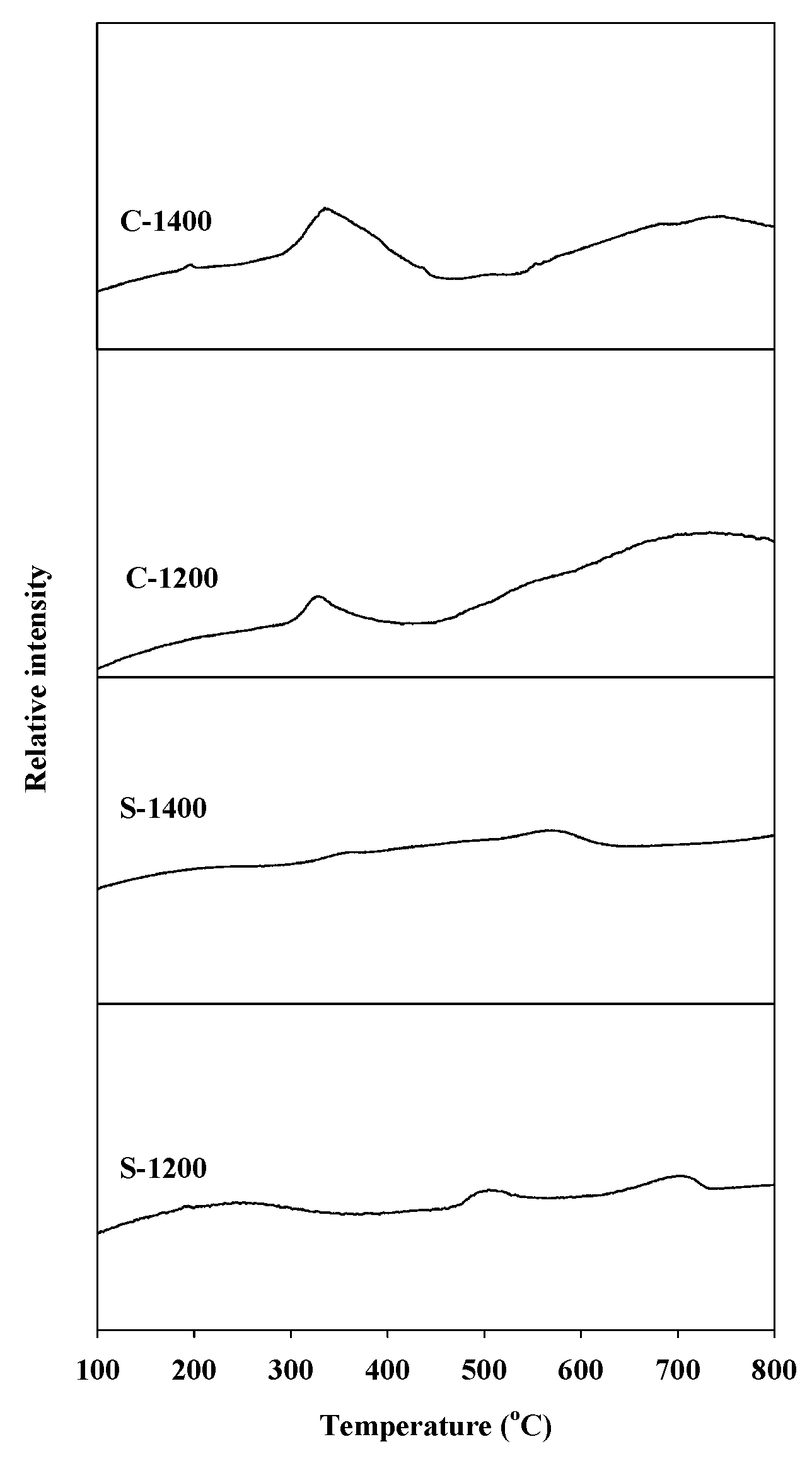

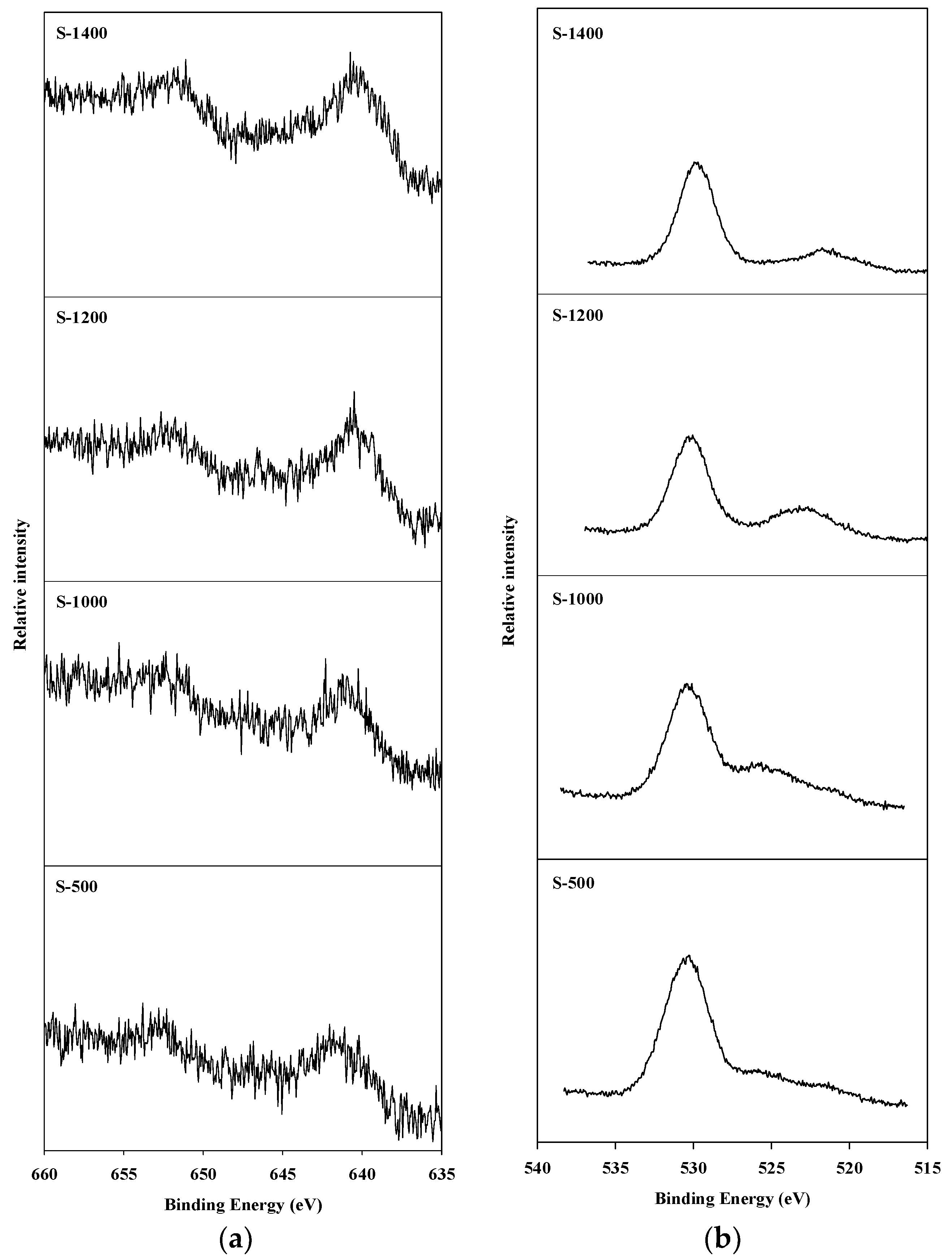
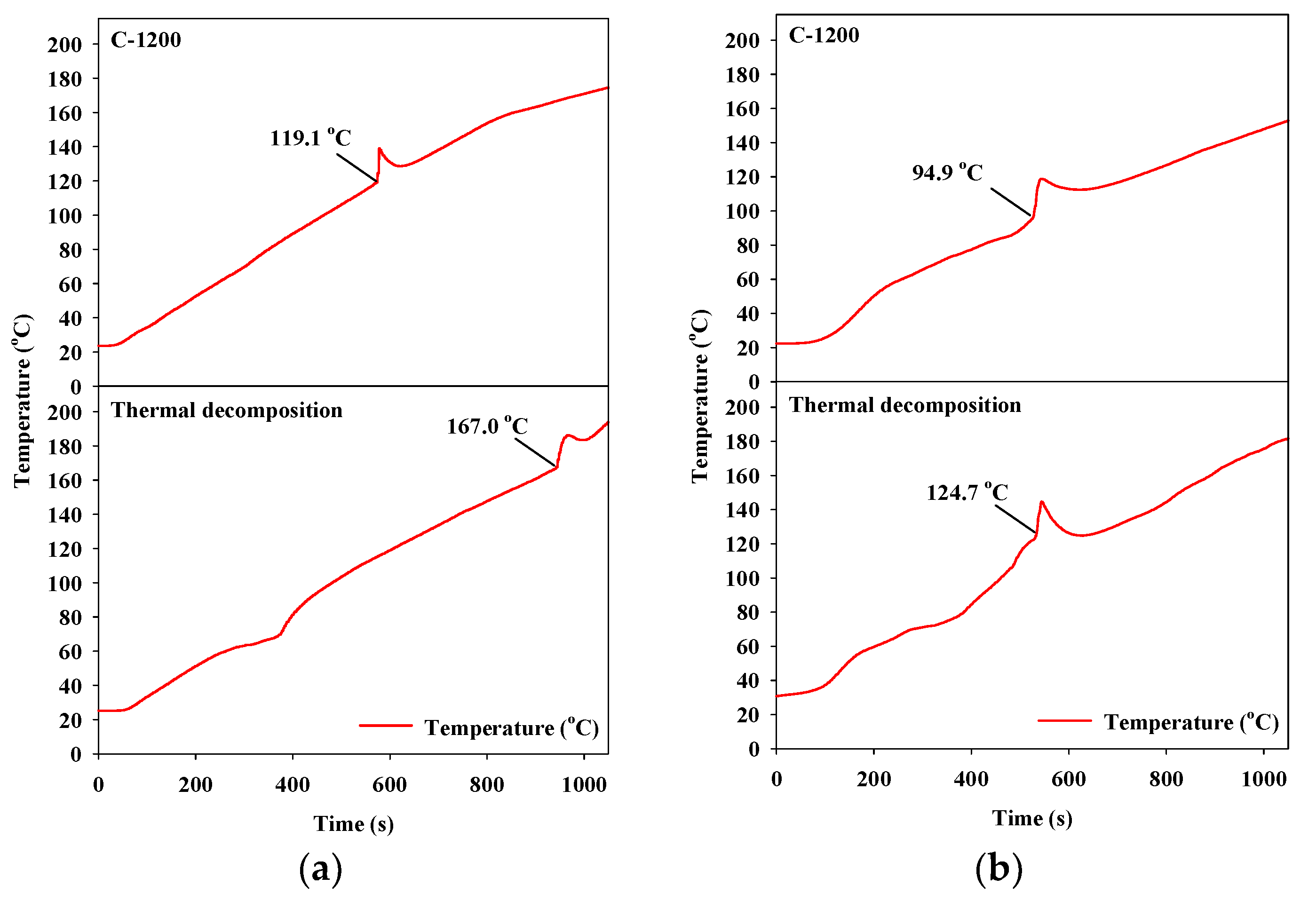
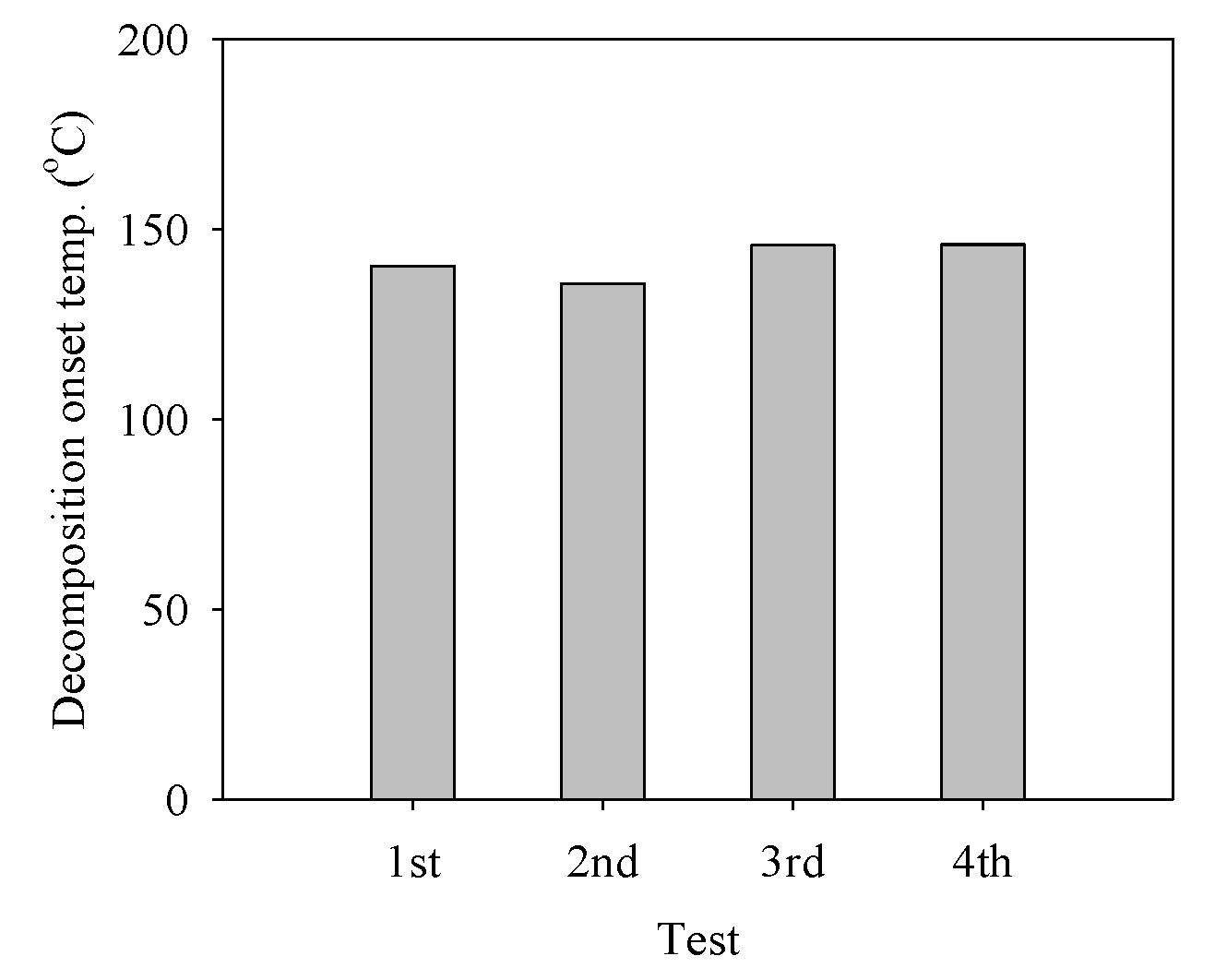
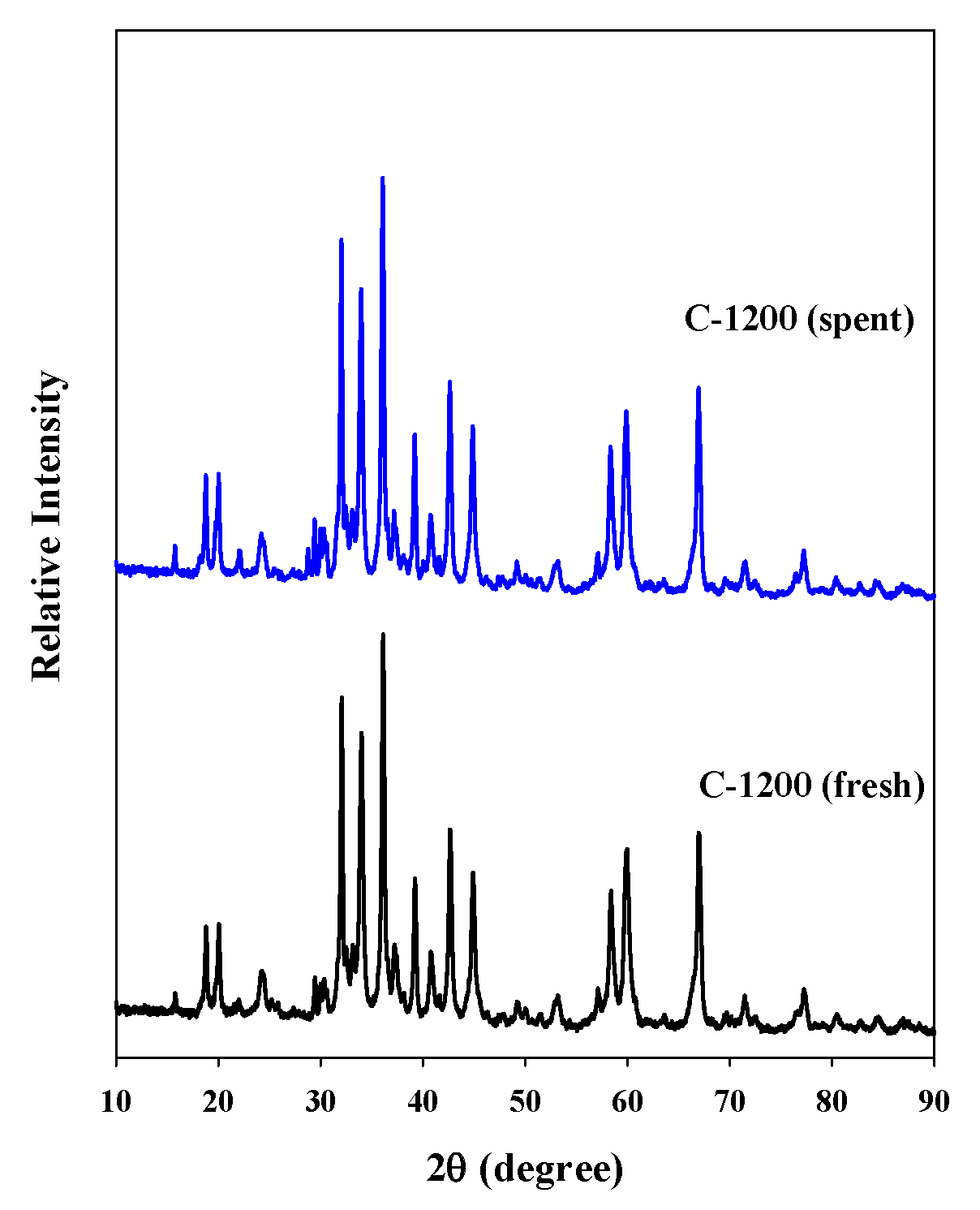

| Catalysts | Synthesis Method | Calcination Temperature (°C) | SBET (m2/g) a | Vp (cm3/g) b |
|---|---|---|---|---|
| C-1400 | Coprecipitation | 1400 | 8 | 0.19 |
| C-1200 | Coprecipitation | 1200 | 17 | 0.23 |
| C-1000 | Coprecipitation | 1000 | 46 | 0.68 |
| C-500 | Coprecipitation | 500 | 129 | 1.39 |
| S-1400 | Sol–gel | 1400 | <1 | 0.05 |
| S-1200 | Sol–gel | 1200 | 7 | 0.16 |
| S-1000 | Sol–gel | 1000 | 119 | 1.12 |
| S-500 | Sol–gel | 500 | 327 | 1.80 |
| Catalysts | wt (%) | Element/Al | |
|---|---|---|---|
| C-1400 | Al2O3 | 21.1 | - |
| MnO | 21.7 | 0.37 | |
| SrO | 40.6 | 0.47 | |
| La2O3 | 12.4 | 0.09 | |
| C-1200 | Al2O3 | 23.2 | - |
| MnO | 23.7 | 0.37 | |
| SrO | 35.2 | 0.37 | |
| La2O3 | 12.8 | 0.09 | |
| C-1000 | Al2O3 | 26.6 | - |
| MnO | 25.3 | 0.34 | |
| SrO | 24.2 | 0.26 | |
| La2O3 | 13.8 | 0.08 | |
| C-500 | Al2O3 | 25.8 | - |
| MnO | 25.5 | 0.35 | |
| SrO | 29.6 | 0.28 | |
| La2O3 | 13.5 | 0.08 | |
| S-1400 | Al2O3 | 48.9 | - |
| MnO | 15.9 | 0.12 | |
| SrO | 23.3 | 0.12 | |
| La2O3 | 9.3 | 0.03 | |
| S-1200 | Al2O3 | 54.2 | - |
| MnO | 16.5 | 0.11 | |
| SrO | 17.8 | 0.08 | |
| La2O3 | 8.5 | 0.02 | |
| S-1000 | Al2O3 | 60.6 | - |
| MnO | 16.5 | 0.10 | |
| SrO | 11.1 | 0.05 | |
| La2O3 | 8.6 | 0.02 | |
| S-500 | Al2O3 | 63.8 | - |
| MnO | 16.0 | 0.09 | |
| SrO | 7.9 | 0.03 | |
| La2O3 | 8.2 | 0.02 | |
| Catalysts | Tdec (°C) a |
|---|---|
| Thermal decomposition | 167.0 |
| C-1400 | 119.8 |
| C-1200 | 119.1 |
| C-1000 | 107.8 |
| C-500 | 98.4 |
| S-1400 | 129.1 |
| S-1200 | 130.7 |
| S-1000 | 92.1 |
| S-500 | 93.6 |
| Catalysts | Tdec (°C) a |
|---|---|
| Thermal decomposition | 124.7 |
| C-1200 | 94.9 |
| S-1200 | 101.8 |
© 2019 by the authors. Licensee MDPI, Basel, Switzerland. This article is an open access article distributed under the terms and conditions of the Creative Commons Attribution (CC BY) license (http://creativecommons.org/licenses/by/4.0/).
Share and Cite
Hong, S.; Heo, S.; Kim, W.; Jo, Y.M.; Park, Y.-K.; Jeon, J.-K. Catalytic Decomposition of an Energetic Ionic Liquid Solution over Hexaaluminate Catalysts. Catalysts 2019, 9, 80. https://doi.org/10.3390/catal9010080
Hong S, Heo S, Kim W, Jo YM, Park Y-K, Jeon J-K. Catalytic Decomposition of an Energetic Ionic Liquid Solution over Hexaaluminate Catalysts. Catalysts. 2019; 9(1):80. https://doi.org/10.3390/catal9010080
Chicago/Turabian StyleHong, Sunghoon, Sujeong Heo, Wooram Kim, Young Min Jo, Young-Kwon Park, and Jong-Ki Jeon. 2019. "Catalytic Decomposition of an Energetic Ionic Liquid Solution over Hexaaluminate Catalysts" Catalysts 9, no. 1: 80. https://doi.org/10.3390/catal9010080
APA StyleHong, S., Heo, S., Kim, W., Jo, Y. M., Park, Y.-K., & Jeon, J.-K. (2019). Catalytic Decomposition of an Energetic Ionic Liquid Solution over Hexaaluminate Catalysts. Catalysts, 9(1), 80. https://doi.org/10.3390/catal9010080






